I Flew the Falco!
![]()
I Flew the Falco! |
|
by Jacques Noetinger
translated by Davide Aldini
|
This may be the first flight report on the Falco, and it was written only a month after the Falco first flew. This appeared in the August 1955 issue of Ali magazine in Italy, and Davide Aldini says the original article appeared in a 1955 issue of Aviation magazine. |
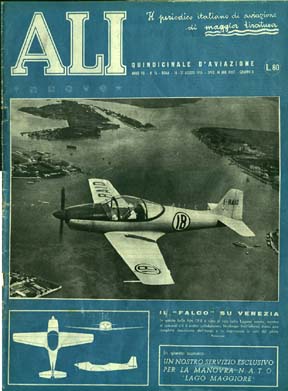
I flew the Falco!
If I will remember my travel in Venice for the wonderful place that I could discover, there are surely other aeronautical reasons that will contribute to make my trip unforgettable. Today I have the luck to make an exciting flight in a new Italian sport airplane that I've been already hearing of, even if I've never seen it; but now I'll have the opportunity to admire it up close.
Today the F.8 is there and it's waiting for me. The Falco is a two-seater, remarkable for the purity of its shape for the fineness of its shaped nose, for the paint finishing and presentation. On the fin (that resembles the Airone's) the registation number is I-RAID... the name says all.
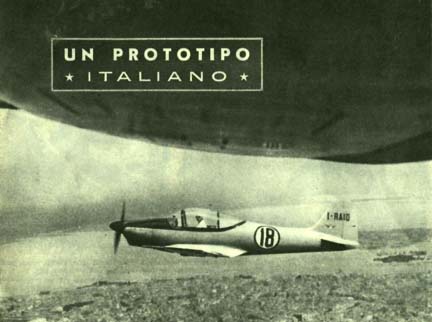
This airplane has the characteristic of having a laminar profile wing, and it is powered by a 90 hp Continental, with a metal propeller. It stands very low on the landing gear.
Without losing time I climb on the wing, from the back. The transparent canopy slides backward and I jump on the cockpit finding out a comfortable room and nice leather interiors. Although this plane made her first flight 15 June, nearly one month ago, the Falco doesn't have time to rest. It's the prototype that has been flying more in the Venice exposition; and it's not surprising that it's necessary to refuel it so often! In fact, this is actually what the mechanics are doing now.
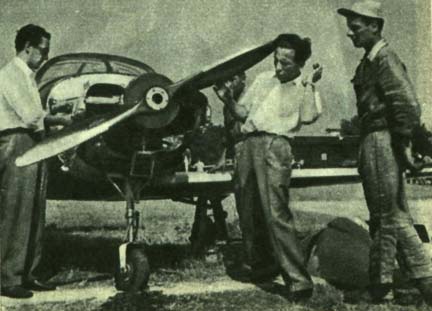
Trouble with the oil lines. Stelio Frati is quite angry on the
right.
Mario Vietri is on the left.
I take a look to the cabin from left to right. On the side there is a wheel that controls the elevator trim, slightly higher I find the fire extinguisher control and over it the throttle control, originally installed in the center of the cockpit.
Looking at the cockpit from left to right I find a first triangular sector in which are located the fire indicator and small green and red lights used to show the landing gear position and the landing gear switch. Then the airspeed indicator, altimeter, turn and bank, vertical speed indicator, g-meter, a tachometer, oil pressure and temperature gauges, fuel quantity gauges and magnetos contact switch. Below the cockpit all on the right side I find the electric master switch. This cockpit has in the middle a vertical rectangle between the two pilot's legs in which I find the engine starter button, the fuel selector valve, mixture and carburetor heat controls. Below there is a small radio. Over the cockpit, there is a small compass.
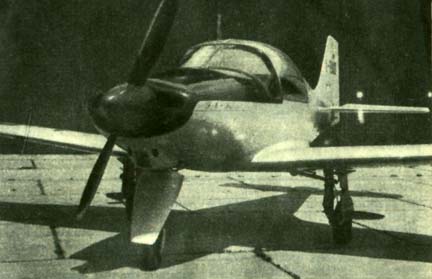
In general, I don't find the instrument layout logical. In particular, I find the tachometer in the far right would have a better place in the one of the g-meter, as well as the electric master switch would be better positioned in the center console. Between the two seats I find the manual flap lever with a stop button for two positions. It's easy to use and to find. Another lever commands the Lockheed brakes that controls each wheel, and the forward landing gear is connected with rudder pedals. Then the electrical switch for the landing gear retraction is duplicated with the manual system... but I will speak about it again.
On the ground visibility is excellent, and this is one of the advantages of tricycle landing gear. I taxi to the runway and lower the flap to take-off position, I align and push the throttle carefully. They told me to allow her to build speed and not to take-off before 100 km/h.
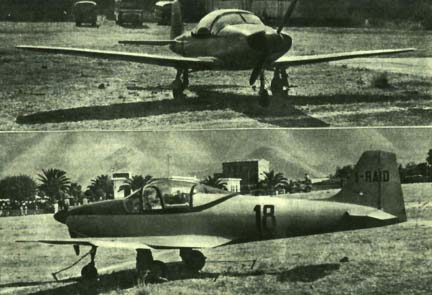
I push the throttle more, that needs attention since the elevator is really effective and I find myself in the air. During the takeoff run I tried the rudder and I found it nervous, and I wait until 200 feet before starting a turn. But then, I immediately feel like I have in my hands a small dogfighter -- the controls are easy but also fast. I have to use the control stick carefully because the controls give an immediate response, but the rudder... the rudder is no joke. But I like this. I confess that I find such nervous controls perfectly in the spirit of a race airplane like the F.8, but the constructor will change them to make the Falco an easier airplane. However I have in my hands the prototype, and I take advantage from it. I make tight turns and then I level off. At only 2150 rpm I get a good 210 km/h.
I make a 360-degree turn, and with a steep bank I can make the Falco turn in a handkerchief without any exhibition of the airplane. I would continue these exercises if only the French 4-seater "Super-Cigale" wouldn't be near with Guy Michelet on board. I get closer to him and I let him shoot at me -- but only with the camera. A small smile, presentation of the airplane on the different angles and conclusion with a descent turn. It's all finished. I have the freedom of the sky! I gain some altitude looking to the unique show offered by the view of the marvellous Venice, lost in the waters of the laguna .
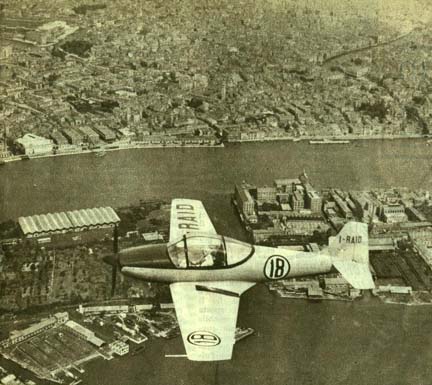
Over Venice
I get closer to the field and at 600 meters I start a lazy eight, wonderful and easy, and while turning I mantain a speed between 120 and 260 km/h. It's not difficult at all. I need only to be easy on the controls. Encouraged from this maneuvers I start an aileron roll at 250 km/h. All is okay even if in the next one I'll begin with less speed and try to push more when inverted. I smell some oil so I decide to come back. I have a prototype in my hands and so I guess there is an oil leak. A normal thing, but in aviation it's better to be prudent, if you want to have the opportunity to become an old pilot! I reduce power and descend looking at the oil pressure gauge that isn't changing and I make nice turns in the descent.
I go for landing and at 200 metres I reduce speed consistently, I lower flaps and landing gear, but the green light doesn't seem to appear. The red light wants to stay on and also the mechanical indicators on the wing and on the nose gear doesn't want to come out. It's not useful to insist, and there must be some electrical contact that is causing the problem. It's to be said that the electric system was made just prior coming to Venice and the constructor hasn't had yet the time to debug. So I decide to use the manual system... Final speed is 110 km/h, and I touch the ground. The shock absorbers work perfectly and, due to the tricycle landing gear configuration, I don't need the same brake work needed on conventional airplanes.
My flight is ended. It has been 20 minutes long. I've just discovered the sporty qualities of an airplane that increases the already good Italian reputation in the production of lights aircraft. Nothing to say on the design; it only needs a more powerful engine for takeoff and a constant speed prop, but isn't this exactly what they're going to do?
If the Falco will have these improvements, it's sure that will have big successes in the future competitions that will be fully deserved.
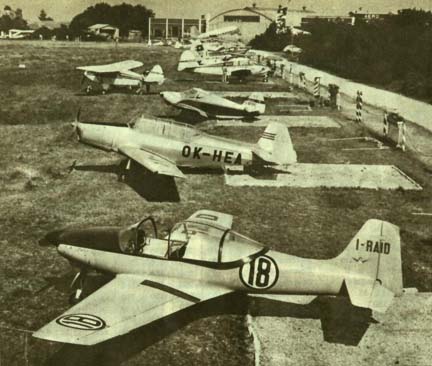
|
|